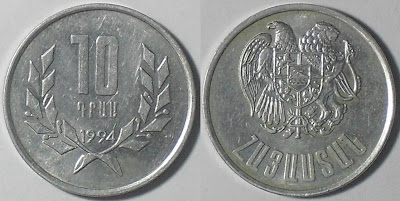20 dram, 2003
50 dram, 2003

The Armenian coat of arms consists of a lion and an eagle on a shield. These are ancient symbols taken from the first Armenian kingdoms dating back to before the birth of Christ.
The shield itself consists of many symbols, with the one at the centre being mount Ararat with Noah's ark on its top. Noah's ark is said to have landed on the top of mount Ararat after the great flood. Ararat is considered to be a national symbol of Armenia. The two eagles looking at each other(bottom left) symbolize the length and breadth of Armenia. In the upper left, we can see a lion with a cross, which was the symbol of the Bagratuni dynasty, which was later destroyed by the expanding Byzantine empire. In the upper right, there is a two headed eagle, symbol of the Arsacid dynasty, the first dynasty of a Christian Armenia. The last symbol is again a lion with a cross, symbol of the Rubenid dynasty, which prospered in the 12th and 13th centuries until the Mamelukes and Turks overtook it.
The lion and the eagle were chosen because of their power, wisdom, courage, patience and nobility among the animals.
The shield itself consists of many symbols, with the one at the centre being mount Ararat with Noah's ark on its top. Noah's ark is said to have landed on the top of mount Ararat after the great flood. Ararat is considered to be a national symbol of Armenia. The two eagles looking at each other(bottom left) symbolize the length and breadth of Armenia. In the upper left, we can see a lion with a cross, which was the symbol of the Bagratuni dynasty, which was later destroyed by the expanding Byzantine empire. In the upper right, there is a two headed eagle, symbol of the Arsacid dynasty, the first dynasty of a Christian Armenia. The last symbol is again a lion with a cross, symbol of the Rubenid dynasty, which prospered in the 12th and 13th centuries until the Mamelukes and Turks overtook it.
The lion and the eagle were chosen because of their power, wisdom, courage, patience and nobility among the animals.
Armenia dram - I
100 dram, 2003
200 dram, 2003
500 dram, 2003
 Weight: 5gm
Weight: 5gmMetal: bimetallic copper-nickel centre in brass ring
Diameter: 22mm
Edge: segmented reeding
Obverse: national arms
The Dram derives its name from the Greek Drachma, one of the earliest copper currencies. The name Dram has not been conjured overnight as we had a currency called Dram from 1199 to 1375, when silver coins called Drams were issued in medieval Armenia. Rubles were used in Armenia until the break up of the USSR in 1991. The Dram came to be used as a currency in 1993 which had an exchange rate of 200 rubles to 1 Dram (or 14.5 Dram to 1 US$).








No comments:
Post a Comment